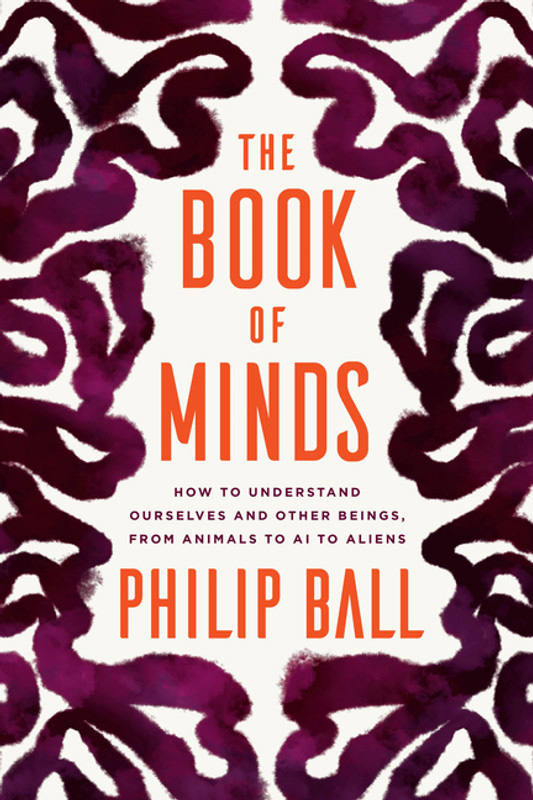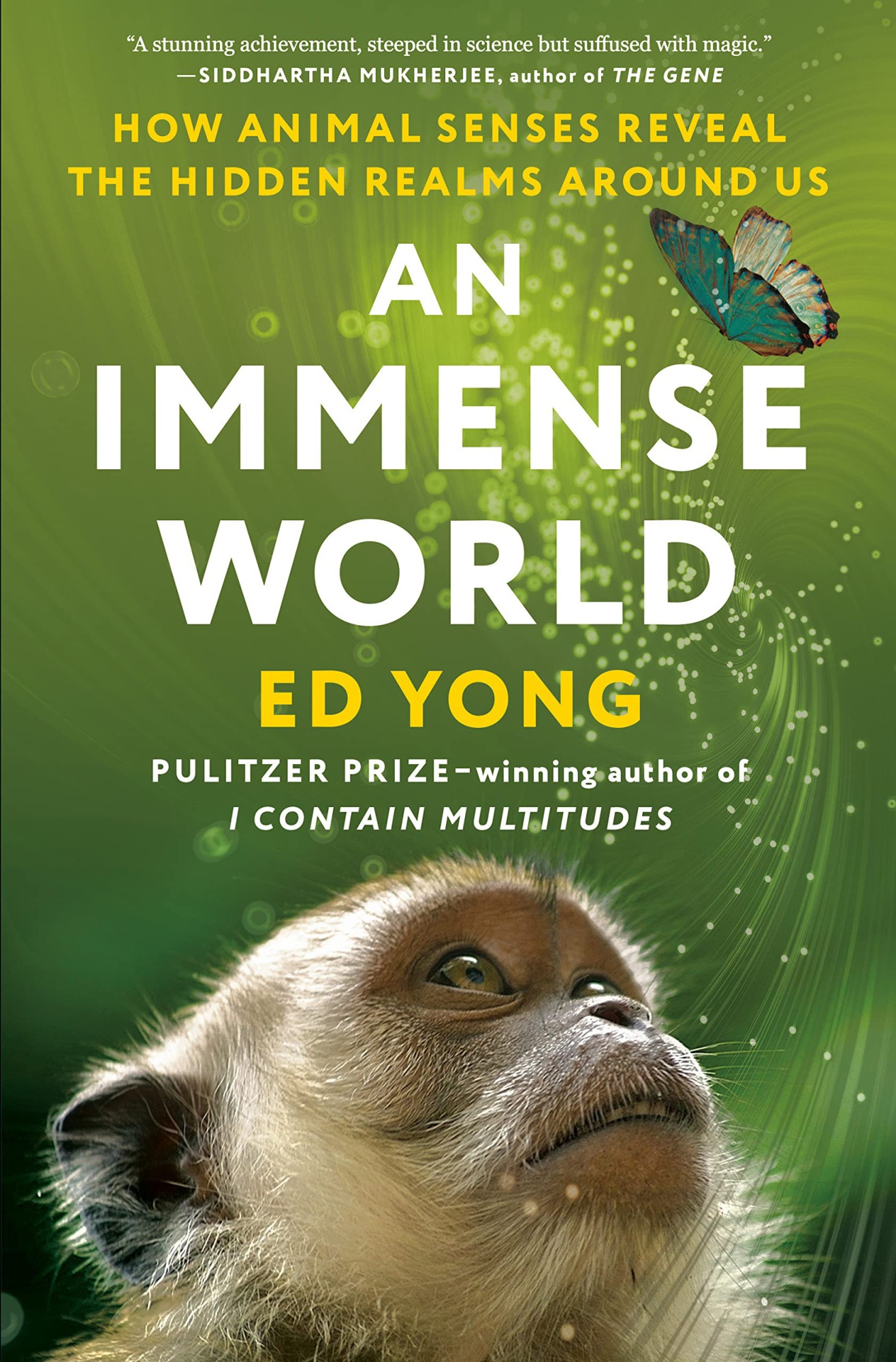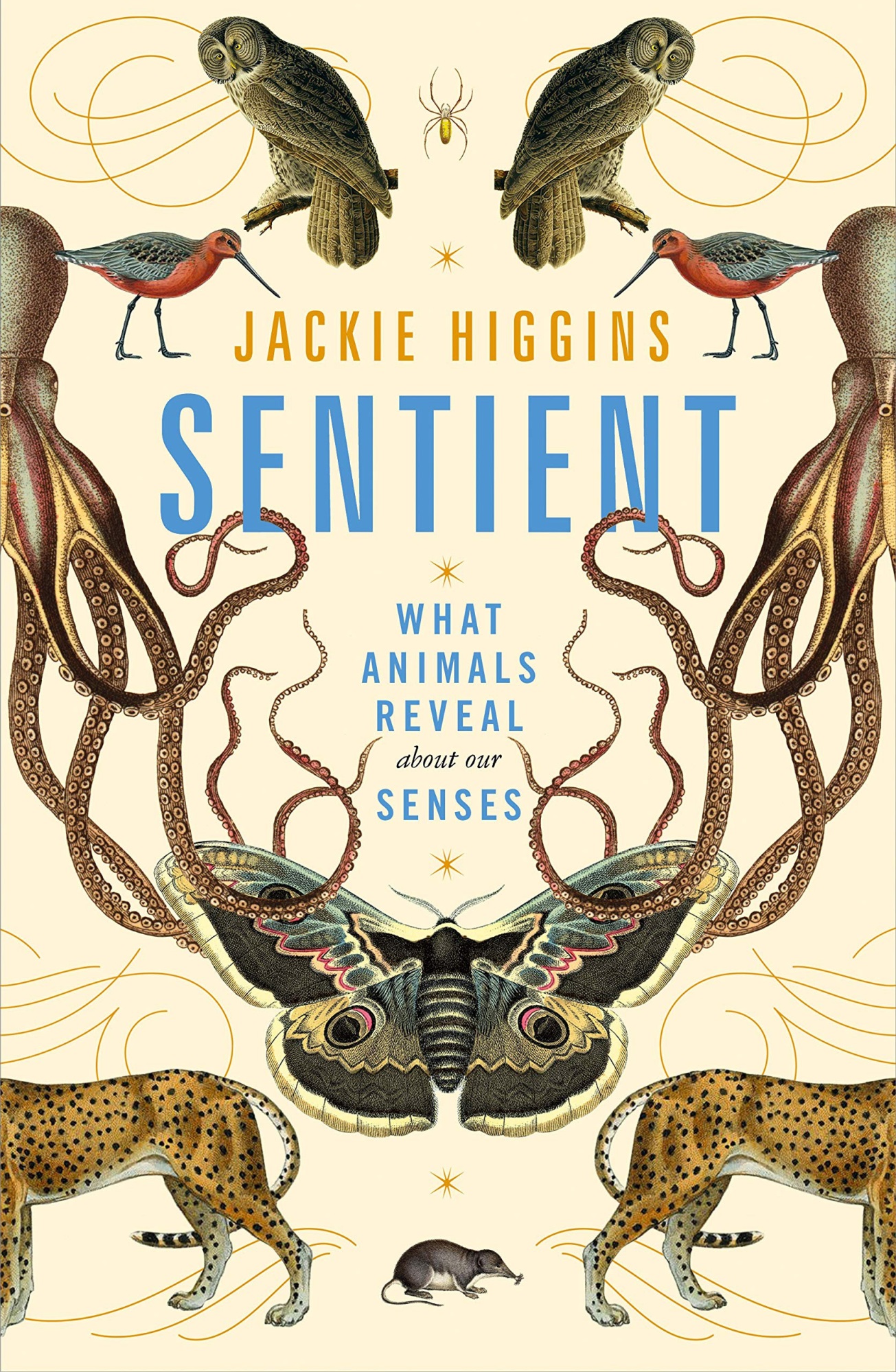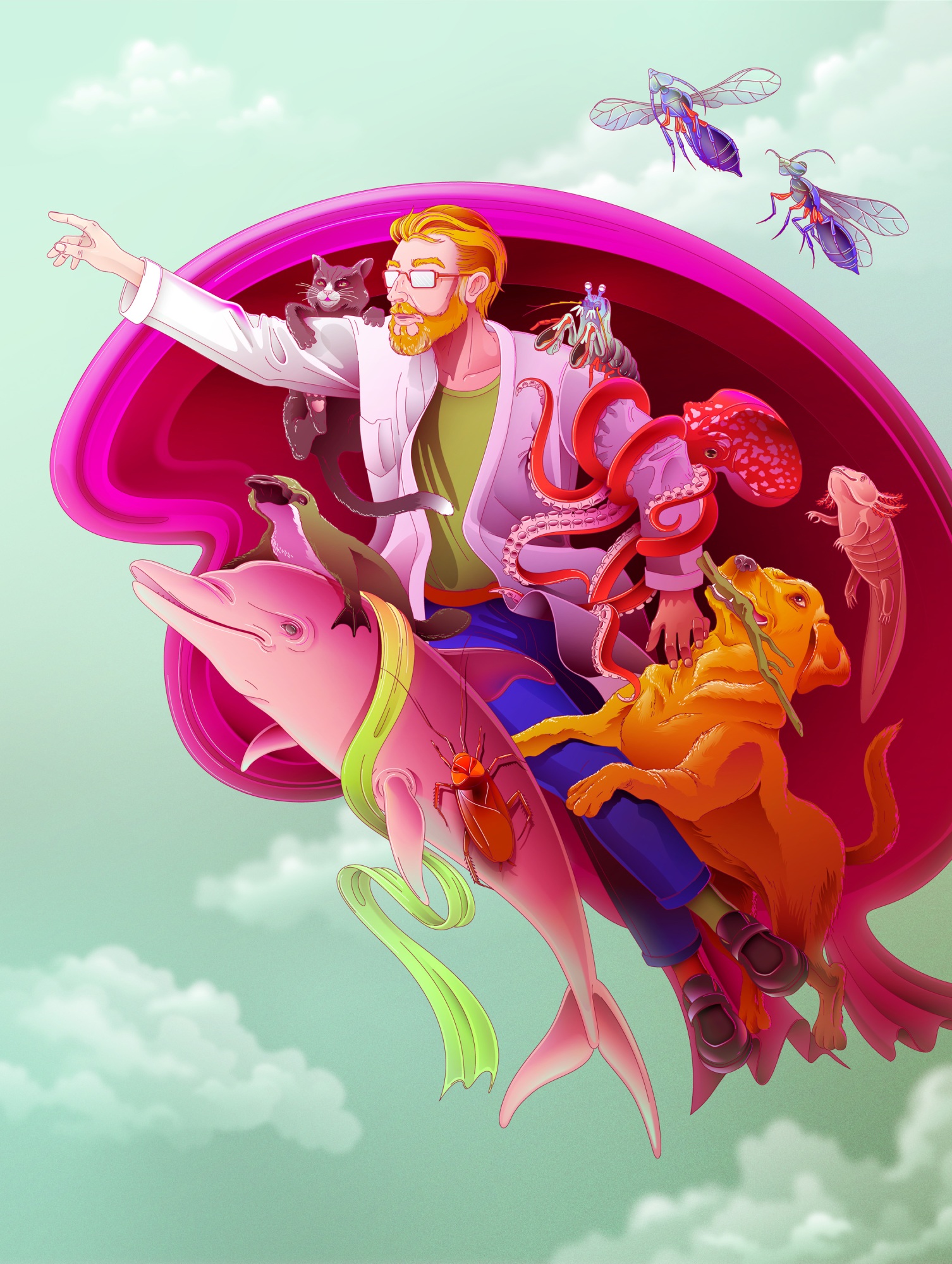Inside the enigmatic minds of animals
The emerald jewel wasp’s unusual arrival into the world—bursting from the body of a zombified cockroach it has eaten from the inside—ranks among nature’s most gruesome miracles. To give her larvae the best start in life, the mother wasp, an inch-long parasite clad in oil-slick iridescent armor, attacks her prey, spearing it once with her two-millimeter stinger and injecting sedative chemicals into the roach’s thorax. She stabs a second time, into her victim’s head, carving through muscle and digestive tubes to inject a potion of venom in the exact location of the cockroach’s tiny brain.
This turns her victim into an obedient pawn. After biting off the tip of the roach’s antenna, the expectant mother can lead the insect like a dog on a leash. Somewhere secluded, she lays an egg on its leg, leaving her young with a passive but still-living mound of flesh, twice her own size, to feed on. In time, the larva will pupate inside it, erupting through its exoskeleton when mature, ready to repeat this grisly process for another generation. When Charles Darwin observed the climactic eruption of wasp from flesh, it was, he wrote, enough to make him question the existence of a loving God. Nevertheless, he couldn’t help but admire the intricacy of this reproductive horror show.
Today, as journalist Ed Yong details in his remarkable new survey of animal perception, An Immense World: How Animal Senses Reveal the Hidden Realms Around Us, we can see far deeper into the process than Darwin could have dreamed. View the jewel wasp’s stinger under an electron microscope, and you’ll find that it is dotted with minutebumps and pits. These are mechanoreceptor cells sensitive to the finest details of touch and texture, and chemoreceptors that sense smell or taste. While the precise purpose of the stinger’s smell receptors is still to be understood, tests have shown that the mechanoreceptors make it a precisely calibrated measuring instrument. As the mother wasp plunges her stinger into the head, “she can detect the distinctive feel of a roach’s brain.”
Yong’s vivid journeys into the sensory realms of other species have given An Immense World pride of place among a growing pile of books detailing the rich inner worlds of animals, including Sentient: What Animals Reveal About Our Senses, by Jackie Higgins, and The Book of Minds: How to Understand Ourselves and Other Beings, from Animals to Aliens, by Philip Ball.
More than ever, we feel a duty and desire to extend empathy to our nonhuman neighbors. In the last three years, more than 30 countries have formally recognized other animals—including gorillas, lobsters, crows, and octopuses—as sentient beings. Yong, Higgins, and Ball together capture what has led to these developments: a booming field of experimental research challenging the long-standing view that animals are neither conscious nor cognitively complex. Western science once treated animals as little more than automata, guided by instinct and hardwiring. But in recent decades researchers have sought to understand complex behavioral phenomena like bee language, vampire bat altruism, and crow ingenuity. The San Francisco–based Earth Species Project, backed by LinkedIn cofounder Reid Hoffman, believes it can take things a step further by decoding patterns in dolphins’ squeaks and pigs’ grunts to create a trans-species translation tool. Talking to animals, once the preserve of animist myths or Dr. Dolittle–like children’s stories, is a prospect that many in tech now suggest is achievable, allowing members of other species to communicate their lives, experiences, and worldviews.

How to Understand Ourselves and Other Beings, from Animals to Aliens
Philip Ball

How Animal Senses Reveal
the Hidden Realms Around Us
Ed Yong

What Animals Reveal About
Our Senses
Jackie Higgins
What would they say? The question philosopher Thomas Nagel posed in his famous 1974 paper on consciousness—“What Is It Like to Be a Bat?”—still lingers. Yong, Higgins, and Ball each claim to chisel away at Nagel’s argument that the experiences of such animals are simply beyond our reach. But though all three assemble troves of fascinating research that provides windows into the lives of animals, we’re left asking how close we really are to bridging the species divide.
In 1909, zoologist Jakob von Uexküll made the then-radical proposal that each animal possesses Umwelt, its own perceptual world, constructed from the information that its senses provide. The Umwelt of the eyeless, body-heat-sensing tick is quite different from that of the blue whale, which can tune in to eclectic water-transmitted signals and extremely low, infrasonic songs that carry thousands of miles. In An Immense World, Yong follows von Uexküll’s framework: he sets up his book as a sort of sensory travelogue through the worlds of various animals, an “attempt to step inside their Umwelten.”
Journeying down this path, Yong makes it clear that many of our nonhuman neighbors, even the humblest bugs, experience the world in moments of richness that are lost to us. To many insects and birds, block-yellow flowers like daffodils are flamed and streaked with painterly brushstrokes of ultraviolet, while those of silverweed are bull’s-eyed with colors we cannot imagine. Plants are not just seen and smelled but felt from a distance: bumblebees sense such plants’ “invisible electric halos”—an electromagnetic force field that every green shoot gives off—with the tiny hairs that make up their fuzz.
In the last three years, more than 30 countries have formally recognized other animals—including gorillas, lobsters, crows, and octopuses—as sentient beings.
Such miniature worlds quake with life. Imperceptibly to us, plants’ springy stems thrum with “haunting, mesmerizing” songs, tapped out by ants, caterpillars, grasshoppers, and other invertebrates that climb on them. In airborne audio, size dictates sound, so large bodies bellow and small animals sound weedy; freed from these constraints, cicadas moo like cows and crickets conjure the sound of revving chainsaws.
While we learn of pit vipers’ heat vision and the sensory electrical field emitted by the black ghost knifefish, it is often the most familiar creatures that reveal the most startling sensory talents. The pet Labrador walking down the street is guided by nostrils that whirl particles into a continuous vortex, creating a stream of nonstop odor. These smells construct a ghostly Umwelt, where objects from the past still reside: a hot dog cart that departed hours before, the skin cells a passerby shed yesterday, or in one test, “a single fingerprint that had been dabbed onto a microscope slide, then left on a rooftop and exposed to the elements for a week.” At night, wandering mice navigate our homes by “whisking,” sweeping the sensitive specialized hairs on their faces to and fro, several times a second, in a manner Yong compares to the action of human eyes, which dart around to construct a scene. Lie awake and you could also, if you had the right ears, hear their ultrasonic, canary-like songs.
Reflecting back on our own sensory abilities, Yong writes of humans: “Our Umwelt is still limited; it just doesn’t feel that way. To us, it feels all-encompassing. It is all that we know, and so we easily mistake it for all there is to know.” Yong, like von Uexküll, sees Umwelt as a great leveler: all animals, put simply, have a partial and concocted picture of reality provided to us by our evolutionary history—developed, like the jewel wasp’s stinger, through generations of predation and mating. An Immense World sets out to elevate other animals’ experience to parity with humans’ and dispense with the idea once and for all that humanity’s experience is uniquely valuable.
In stating his ambition to “explore their senses to better understand their lives,” Yong is true to his word. A longtime staffer for the Atlantic, he has an Attenborough-like talent for excavating simple stories from the unbounded mess of the natural world. A look at the eyes of scallops, for example, becomes a window through which to marvel at the dozens or even hundreds of bobbling eyeballs attached to this seafood staple. Yong describes visiting bay scallops with eyes like “neon blueberries.” When threatened, the creatures flap furiously toward freedom, “opening and closing their shells like panicked castanets.”
An Immense World’s most revelatory anecdotes are those that reverse our worldview and help us to understand how evolutionary pressures have structured physical reality. He tells us that bees, like us, have trichromatic eyes—they perceive three primary colors. In their case, however, the light-sensitive cells are tuned to green, blue, and ultraviolet. “You might think that these pollinators evolved eyes that see flowers well, but that’s not what happened,” he writes. “Their style of trichromacy evolved hundreds of millions of years before the first flowers appeared, so the latter must have evolved to suit the former. Flowers evolved colors that ideally tickle insect eyes.”
Unlike Yong, Jackie Higgins sees animal talents as a lens onto our own faculties. Higgins, who was a science filmmaker for the BBC before becoming an author, centers each chapter of Sentient on one animal’s remarkable sensory adaptation but takes anecdotal diversions, à la Oliver Sacks, to explore cases on the edges of human capability. Taking cues from The Naked Ape—Desmond Morris’s hippie-era melding of zoology and ethnography that interpreted human behavior as the upshot of grand, speculative evolutionary narrative—she prizes the study of animals as “a mirror we can hold up to satisfy self-obsession,” adding that “it offers another perspective on why we humans look, act and feel as we do.”
“We do not see with our eyes, but with our brains. Similarly, we do not solely hear with our ears, smell with our noses, taste with our tongues, or feel with the sensors in our fingers.”
Paul Bach-y-Rita
There’s the peacock mantis shrimp, which has the most complex eyes so far discovered (with 12 types of photoreceptors to our three), and the star-nosed mole, which packs six times more touch sensors into its centimeter-wide splayed snout than you have in an entire hand. Each chapter spotlights one sense, so that in considering color vision, she pairs the example of the shrimp with those of humans grappling with their own equivalent sense: residents of the Pingelap Atoll, for example, the “island of the color-blind,” and an anonymous Englishwoman, code-named cDa29, who has a fourth type of photoreceptor that allows her to see millions of colors invisible to the rest of us.
In reading Higgins, we get to spend more time with an organ that appears deliberately unprobed by Yong: the brain. To her, the brain is everywhere, necessarily so as “our body’s all-important sense organ.” Paraphrasing the American neuroscientist Paul Bach-y-Rita, Higgins writes, “We do not see with our eyes, but with our brains. Similarly, we do not solely hear with our ears, smell with our noses, taste with our tongues, or feel with the sensors in our fingers.” In Sentient, we learn that spread across the human brain we can find a “sensory homunculus,” a touch map of the body with supersize areas corresponding to our hands and lips, reflecting the density of touch sensors in these zones. There are animal equivalents—“mouseunculus,” “raccoonunculus,” “platypunculus,” and star-nosed “moleunculus”—that likewise represent the primacy of those species’ sensitive whiskers and noses. Indeed, the most affecting sections of the book get closest to the mind, like the chapter on the skin’s “slow lane,” the touch system that responds to caress. The system is found in social mammals, including ourselves but also vampire bats, which have been observed gifting each other blood after caring licks. It is a rare sense that communicates not so much information as mood: “By tuning us to tenderness,” Higgins writes, “it transforms touch into interpersonal glue and the skin into a social organ.”

Through this, we learn that most of what makes up the perceptual world is constructed in the darkness of our head rather than in the sense organs themselves, whose role is limited to translating stimuli into electrical signals. Yet as Higgins and Yong conclude that we really can understand a lot about what it’s like to be another creature, we’re left wondering about this central organ, not having built a clear picture of any other species’ brain—its structure and functioning—nor elucidated much of what’s going on inside it: its cognition or thought. Enter Philip Ball’s The Book of Minds. For Ball, senses are just one way into a wide-horizoned exploration that begins with animal minds and cuts a course through consciousness, artificial intelligence, extraterrestrials, and free will. His book asks: What kinds of minds exist, or could exist, beyond our own? Ball, a prolific science writer and former editor at the journal Nature, also sets out with a story from Sacks, who recalled pressing his large, bearded face against the window to the enclosure of an orangutan mother at the Toronto Zoo. As each placed a hand against opposite sides of the pane, Sacks wrote, the two hairy primates shared an “instant, mutual recognition and sense of kinship.”
Even if it is unclear whether we can know what it is like to be a bat, it seemed obvious to Sacks that what it is like to be an orangutan is not just knowable, but something we can intuit readily. Ball’s exploration of the minds of others negotiates this path between solipsism—the skeptical philosophical position that none of us can know anything beyond our own mind—and anthropomorphism, which naively projects our own qualities onto nonhumans. According to him, humans, bats, and orangutans are just three instances within a “Space of Possible Minds” that could also include AI, aliens, and angels.
Discovering one’s own brain is like discovering some alien technology: “With its 86 billion neurons and 1,000 trillion connections, [it] is the most complex object we know of, yet its logic is not one for which other phenomena prepare us.”
Rather than posing binary questions—“Is this animal sentient? Has a chatbot become conscious?”—Ball proposes to map out potential minds by their capabilities. This takes a quite literal form in graphs that plot thinking or processing things, from octopuses to Roomba robot vacuums, along a pair of axes. Neuroscientist Christof Koch has plotted one such graph of “intelligence” against “consciousness,” and computer scientist Murray Shanahan has done so with “human-likeness” set against “capacity for consciousness.” Ball aims to chart a map to the other minds out there that not only display qualities different from ours but in some cases rival and exceed them—as chess-playing AIs now routinely do.
Ball’s own sprawling narrative shows why Yong might have felt it wise not to spend too long with the brain.The eye was Darwin’s go-to example of the dazzling complexity the theory of evolution had to explain. Yet the eye is a device made of clearly comprehensible parts, “including lenses for focusing light, a moveable aperture, photosensitive tissues to record images, delicate colour discrimination, and more.” You could say the same about the ear or other sense organs. “But the brain?” writes Ball. “It makes no sense at all. To the eye it is a barely differentiated mass of cauliflower tissue with no moving parts and the consistency of blancmange, and yet out of it has come Don Quixote and Parsifal, the theory of general relativity and The X Factor, tax returns and genocide.” Discovering one’s own brain is like discovering some alien technology: “With its 86 billion neurons and 1,000 trillion connections, [it] is the most complex object we know of, yet its logic is not one for which other phenomena prepare us.” It is not for nothing that the question of how conscious experience arises out of all this mushy matter is known as the “hard problem of consciousness.”
It would be harsh to criticize Ball for not coming to many clear answers. He is at his best when reformulating the question and problematizing the hasty inferences that plague both AI and animal research. In one section, Ball looks directly at trans-species translation. He tells the story of the marine biologist Denise Herzing, who trained a dolphin pod to associate a set of whistles with sargassum seaweed, one of their favorite playthings. The dolphins assimilated this “word” and later, in the wild, Herzing claimed, used it to convey the same meaning.
This attempt to speak “Dolphinese” raises a head-spinning set of questions. Is this really a language, like the ones we humans make? Are multiple senses involved in creating the meaning for dolphins—as humans combine words and body language? At least since the 1960s, scientists have believed that dolphins as well as some apes have language capabilities—Koko, a gorilla who learned and communicated with some hand gestures, being the most famous. But today we are more hesitant than ever, fearful of anthropomorphism, to ascribe too much importance to acquisition of human language.
Throughout, Ball argues that we must be as skeptical of the “philosophical dead end” of solipsism as we are of those who rush to project humanlike experiences onto pets, chimps, or—like one recently dismissed Google engineer—fairly rudimentary chatbots. Ball’s deep dive into the problems of ascribing conscious minds to others sits neatly next to Yong’s and Higgins’s celebrations, which instead find purpose in imagining just how wide the world might look if other beings really could tell us what they see.
Matthew Ponsford is a freelance reporter based in London.
